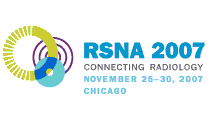
Abstract Archives of the RSNA, 2007
Lily Yvonne Kernagis MD, Presenter: Nothing to Disclose
Susan Pae Weinstein MD, Abstract Co-Author: Stockholder, Hologic, Inc
Emily F. Conant MD, Abstract Co-Author: Research grant, General Electric Company
Mark Alan Rosen MD, PhD, Abstract Co-Author: Nothing to Disclose
Mitchell Dennis Schnall MD, PhD, Abstract Co-Author: Research funded, Siemens
Consultant, General Electric Company
To prospectively compare breast cancer detection rate on film screen mammogram (FSM), full field digital mammogram (FFDM), whole breast ultrasound (WBUS) and contrast enhanced MRI (CEMRI) in a high risk screening population.
570 high-risk women were prospectively screened using FSM, FFDM, WBUS, and CEMRI. High risk was defined as any of the following: ³ 25% lifetime risk based on genetic testing or the Claus or Gail models, diagnosis of LCIS, ADH or ALH, received chest wall radiation prior to puberty, history of breast cancer in the contralateral breast. All the patients were clinically asymptomatic at the time of enrollment. Three radiologists, blinded to the results of the other imaging modalities, rendered interpretations. One radiologist interpreted the FSM and performed the WBUS. A second radiologist interpreted the soft copy FFDM. A third radiologist interpreted the CEMRI study. The blinded interpretations of each modality were recorded and the results were unblinded at conference. The final interpretations were rendered by the group in a consensus forum.
Of the 570 screened women, 96 lesions were recommended for biopsy in 82/570 (14.4%) women. Of the biopsied lesions, 12/96 (12.5%) lesions were malignant in 12/82 (14.6%) women. The pathology results were invasive ductal cancer (6, 50.0%), invasive lobular (1, 8.3%), invasive cancer NOS (3, 25.0%), DCIS (2, 16.7%). Some cancers were only seen on one imaging modality. 7/12 (58.3%) cancers were detected only on MRI, 1/12 (8.3%) cancer was only detected on US, and 1/12 (8.3%) cancer was only detected on FFDM. There was no case of FSM only detected cancer. Three cancers were seen on more than one modality. The overall cancer detection by modality at the time of consensus conference is as follows: 10/12 (83.3%) cancers were visible on CEMRI, 3/12 (25.0%) on US, 3/12 (25.0%) on FFDM, and 2/12 (16.7%) on FSM.
MRI detected the highest percentage of clinically occult breast cancer in our high-risk population; more than FFDM, WBUS and FSM. MRI may be a useful adjunctive screening tool in addition to mammography in the high-risk population.
Breast MRI has a role in screening high risk women.
Kernagis, L,
Weinstein, S,
Conant, E,
Rosen, M,
Schnall, M,
Multimodality Prospective Screening of Women at High Risk for Breast Cancer. Radiological Society of North America 2007 Scientific Assembly and Annual Meeting, November 25 - November 30, 2007 ,Chicago IL.
http://archive.rsna.org/2007/5014428.html

